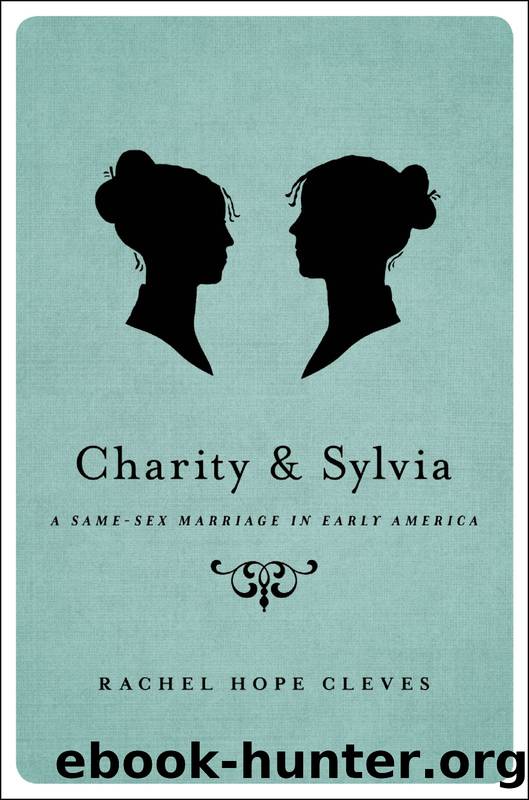Charity and Sylvia by Rachel Hope Cleves

Author:Rachel Hope Cleves
Language: eng
Format: epub
Publisher: Oxford University Press
Published: 2014-12-15T00:00:00+00:00
14
Miss Bryant Was the Man
1820
IN AUGUST 1820, census takers fanned out across the state of Vermont to execute the decennial record of the nationâs population. An appointed recorder visited roughly 130 households in Weybridge, noting the race, sex, age, and occupation of the inhabitants within each. The only names he took were the heads of household. A great many Benjamins, Samuels, and Williams filled his rolls. About halfway through his record, after knocking at the doors of Asaph Hayward and Benjamin Hagar, the visitor inscribed the first womanâs name into the record. Occupying a small house near the Hagar farm, he found two women, in the age group 26â44 years, who operated a commercial business. In careful penmanship, he recorded the proper spelling of the head of the household: âCharity Bryant.â1
The census taker ten years later had fine handwriting, but poor spelling. Between the Hayward and Hagar farms, he enumerated a household headed by âCarity Briand,â including two women, one aged 40â50 and the other 20â30.2 Sylvia was actually thirty-five at the time, but compared to most Weybridge women her age, who bore the physical strain of multiple pregnancies, Sylvia likely appeared quite young. In 1840, the census taker got both Charityâs name and Sylviaâs age right. He also recorded a third woman aged 30â40 living in the household, one of the coupleâs sewing assistants.3 The 1840 census included many more women as heads of household than had been the case twenty years before, but Sylvia remained unnamed within the federal population count until 1850, the year that dependentsâ names finally entered the rolls. In that Seventh Census of the United States, Sylvia Drake appeared for the first time in the official records of the American population. She was sixty-six years old.4
By 1850, the legal doctrine of âcovertureâ that had long subsumed married womenâs civic identities under the identities of their husbands was beginning to weaken. The passage of married womenâs property acts in many states entitled wives to own property separately from their husbands; an emergent womenâs rights movement called for womenâs prerogative to make their own decisions about childbearing; and wives and other dependent members of households finally had their names entered into the census. But the dismantling of coverture was a slow-moving process. Wives living with their husbands did not become coequal heads of household in 1850; they retained their subordinate position beneath their husbands. Accordingly, when Sylvia Drake was counted in the seventh decennial U.S. census, her name fell below Charity Bryantâs.5
From the July day in 1807 that Sylvia came to live with Charity until the October day in 1851 that death divided them, Charity headed the womenâs household in their own eyes, as well as in the eyes of their family, their friends, and their community. William Cullen Bryant likened Charity to a âhusband,â and Sylvia to her âfond wife.â6 Charity used the term âmy help-meetâ to describe Sylvia, adopting a common synonym for wife, given to Eve in the book of Genesis. By extension, Charity figured herself as the Adam-like patriarch within the household.
Download
This site does not store any files on its server. We only index and link to content provided by other sites. Please contact the content providers to delete copyright contents if any and email us, we'll remove relevant links or contents immediately.
| Africa | Americas |
| Arctic & Antarctica | Asia |
| Australia & Oceania | Europe |
| Middle East | Russia |
| United States | World |
| Ancient Civilizations | Military |
| Historical Study & Educational Resources |
Machine Learning at Scale with H2O by Gregory Keys | David Whiting(4185)
Never by Ken Follett(3794)
Fairy Tale by Stephen King(3220)
The Man Who Died Twice by Richard Osman(2997)
Oathbringer (The Stormlight Archive, Book 3) by Brandon Sanderson(2888)
Will by Will Smith(2794)
Rationality by Steven Pinker(2291)
The Dark Hours by Michael Connelly(2246)
Can't Hurt Me: Master Your Mind and Defy the Odds - Clean Edition by David Goggins(2228)
The Dawn of Everything: A New History of Humanity by David Graeber & David Wengrow(2122)
Friends, Lovers, and the Big Terrible Thing by Matthew Perry(2120)
Principles for Dealing With the Changing World Order: Why Nations Succeed and Fail by Ray Dalio(1974)
HBR's 10 Must Reads 2022 by Harvard Business Review(1778)
A Short History of War by Jeremy Black(1763)
Go Tell the Bees That I Am Gone by Diana Gabaldon(1687)
515945210 by Unknown(1600)
A Game of Thrones (The Illustrated Edition) by George R. R. Martin(1591)
Kingdom of Ash by Maas Sarah J(1529)
443319537 by Unknown(1470)
